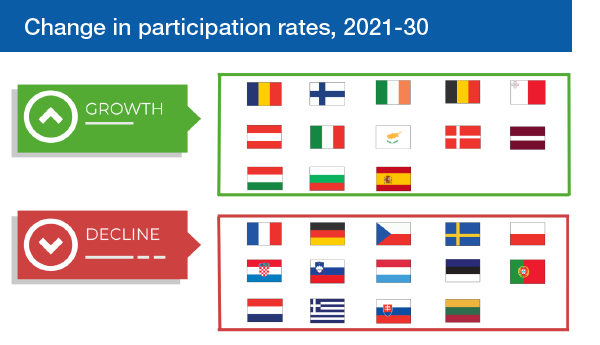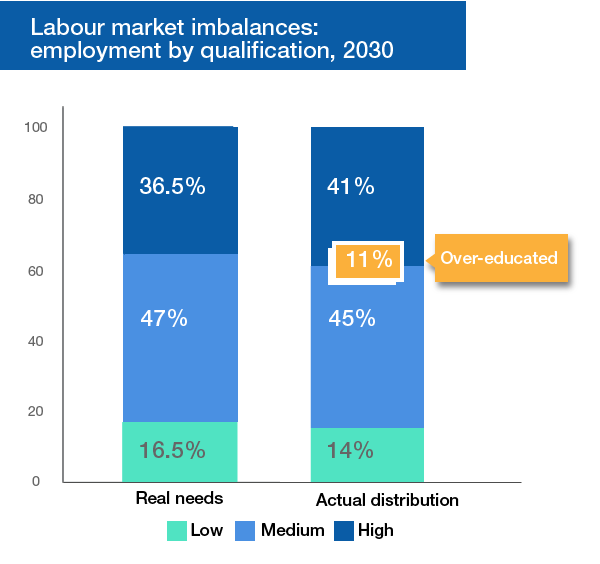Cedefop has just released its 2020 skills forecast, estimating the annual employment needs across sectors and occupations in the EU Members States (plus a few more countries) up to 2030.
The 2020 update was developed before the coronavirus pandemic. The short-term economic impact of the lockdown in many countries is uncertain; the current short-term forecast is therefore likely to be over-optimistic. However, the key long-term factors (such as the ageing population, increasing use of automation/artificial intelligence, globalisation, resource scarcity and move towards a carbon neutral economy) will still hold as the EU Member States put plans into place to deal with the virus, and their economies move forward. The trends in the longer-term forecast are therefore also likely to hold.
Cedefop Executive Director Jürgen Siebel notes: ‘Our skills forecast is a unique database in Europe, constantly used for analysing labour market phenomena and assessing the impact of policies even beyond the EU skills agenda (e.g. the green deal, the transition to a circular economy, etc.). The 2020 release presents the baseline scenario for skills in Europe if there were no pandemic. Using this baseline, we can assess the coronavirus impact on sectors and occupations for the post-crisis “new normal” across all Member States.’
Key challenges
Future labour market participation rates are expected to fall in many countries. This is the result of an ageing workforce and a decreasing size of prime-aged workers. Over the forecast period, this trend is not expected to cause a decline in the workforce, as population is increasing, but it may be a matter of time before Europe’s labour force starts declining in numbers. The question arises whether the measures focusing on specific groups of workers, such as the extension of working life, flexible forms of work and support of female participation, are enough to solve the overall problem. Moreover, the current crisis may serve as an alarm bell for an ageing workforce and population that is more vulnerable to a recurrence of a similar pandemic in the future.
Figure 1: Trend in participation rate, EU-27, 2021-30

Source: Cedefop 2020 skills forecast.
In the next decade, job polarisation is expected to grow further. Jobs in the higher and lower skills spectrum are expected to grow, hollowing out those in the middle. Overall, four in five new jobs will be in high-skilled occupations.
The job polarisation phenomenon is not new but current technological advances seem to be affecting routinised occupations the most. Many clerks, such as general and keyboard clerks or numerical and material recording clerks, will lose a significant share in employment as they now become less relevant.
This trend is likely to be further reinforced by the pandemic, which has hit harder sectors that typically employ workers with a medium level of skills. Such occupations are also threatened more by technological advances. The coronavirus may result in their replacement by technology.
A highly skilled workforce
The skills forecast also highlights a continuous skills upgrade trend. It is estimated that by 2030 the needs for workers with high level of qualifications will account for about 36.5% of total employment. However, since their supply is outpacing demand, it is more likely that the share of total employment with high level of qualifications will account for 41%.
Although we are heading towards a highly skilled workforce, a significant part may not have the opportunity to use the skills it has acquired. This might lead to intensification of work at lower levels, raising skill needs and making mid-level occupations even more demanding.
Still, as Cedefop expert Ilias Livanos notes, ‘the skills upgrade or the so-called over-education should not always be interpreted negatively, as we observe that during the coronavirus crisis, it is the high-skilled workers that find it easier to adapt to the new ways of working by making good use of technological advances.’
Figure 2: Real needs and actual distribution of employment by level of education, EU-27, 2030

Source: Cedefop 2020 skills forecast.
You can access the detailed results of the 2020 skills forecast and the future prospects of sectors and occupations for each country here.




